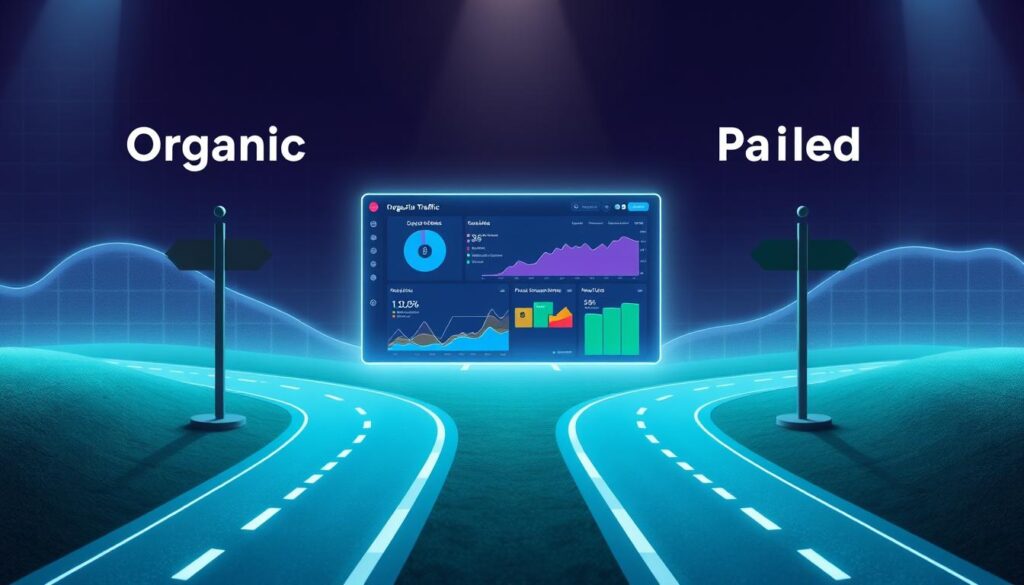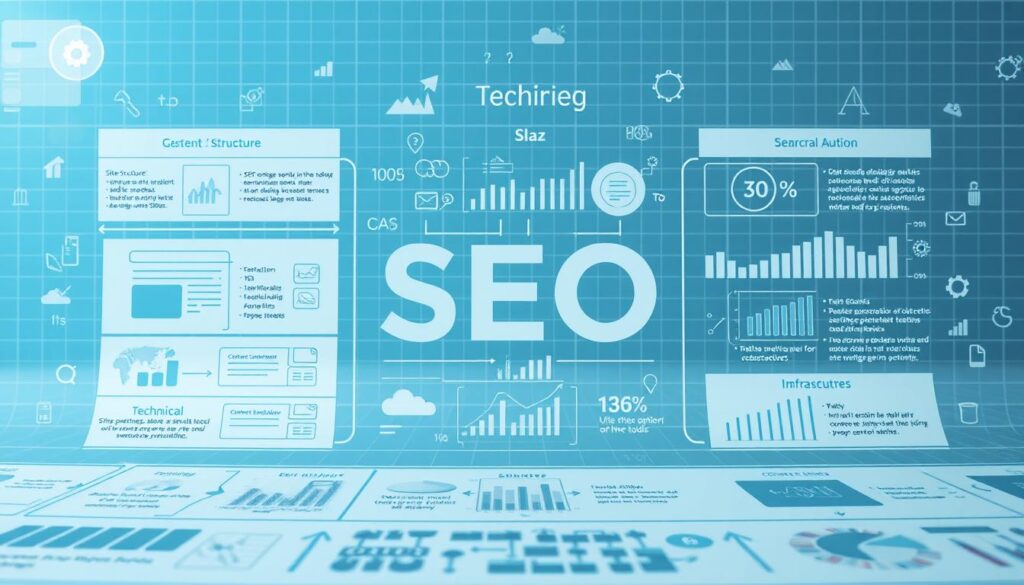Since the late 1990s, businesses have debated the value of optimizing for search engine rankings. Some marketers swear by its ability to drive sustainable growth, while others question the upfront investment. The truth? Effective strategies go far beyond just chasing algorithms—they build lasting connections with audiences.
Early adopters saw how improving online visibility could transform brands into industry leaders. Skeptics, however, often point to slow results or unpredictable updates. Modern practices blend technical expertise with creative content development, creating pathways for businesses to stand out in crowded markets.
This guide cuts through the noise. We’ll explore real-world success stories, break down costs, and reveal metrics that prove why prioritizing visibility matters. While opinions vary, one fact remains clear: companies that adapt to evolving search trends consistently outperform competitors.
Key Takeaways
- Search engine optimization builds brand credibility over time
- ROI debates center on upfront costs versus long-term gains
- Technical and creative strategies work together for visibility
- 2024 data shows optimized sites dominate key industries
- Case studies reveal measurable traffic and conversion growth
Understanding SEO: Definition and Evolution
Modern digital strategies rely on aligning with how people discover solutions online. At its core, search optimization balances technical precision with human-centered design. It’s not magic tricks for rankings—it’s a systematic approach to making your website more useful to visitors and crawlers alike.
What is SEO and What It Isn’t
True optimization focuses on three pillars: content quality, technical performance, and audience relevance. Unlike outdated tactics like stuffing pages with keywords, modern methods prioritize answering real questions. Think of it as building a helpful library rather than plastering billboards.
Common myths suggest shortcuts exist. In reality:
- It’s not about tricking algorithms
- It is about structuring data for clarity
- It’s not a one-time project
- It is an ongoing conversation with your market
The Evolution of SEO Since 1997
The practice transformed dramatically since search engines first gained traction. Early days saw webmasters repeating phrases like “best pizza in Chicago” 50 times per page. Google’s 2003 Florida Update changed everything—penalizing spammy tactics while rewarding genuine value.
Key shifts include:
- Mobile-first indexing (2018) prioritizing smartphone-friendly sites
- Voice search optimization becoming critical with smart speakers
- E-E-A-T guidelines emphasizing expertise and trustworthiness
Today, success means adapting to how people actually search. A local bakery might optimize for “gluten-free birthday cakes near me” instead of generic terms. This evolution mirrors broader changes in tech and consumer behavior—proving that flexibility drives lasting results.
Core Benefits of SEO Investment
In today’s digital marketplace, visibility isn’t just about being seen—it’s about being trusted. Companies that rank higher in search results gain credibility, as users perceive top listings as more reliable. Studies show nearly 70% of online experiences start with a search engine, making organic visibility critical for reaching audiences when they’re actively seeking solutions.
Increased Visibility and Trust
Appearing in top search positions acts like a digital endorsement. Brands that consistently answer user questions build authority over time. For example, a local hardware store optimizing for “energy-efficient window installation” attracts homeowners researching upgrades. This relevance fosters trust, turning casual browsers into loyal customers.
Cost Savings Compared to Paid Advertising
While paid ads deliver quick clicks, their costs add up fast. Data reveals organic strategies save up to 400% compared to pay-per-click campaigns. Unlike ads that vanish once budgets run dry, optimized content keeps driving traffic months or years later. A bakery ranking for “custom wedding cakes” might reduce ad spending by 60% while maintaining steady inquiries.
Smart marketing blends short-term wins with long-term growth. By prioritizing sustainable tactics, businesses build lasting connections without draining resources. The result? Higher returns, stronger reputations, and audiences that choose you first.
The Impact of SEO on Traffic and Website Visibility
Traffic generation splits into two paths: quick wins versus lasting growth. While paid ads offer immediate visibility, organic listings build momentum that strengthens over years. Data shows 70% of users click natural results, viewing them as more trustworthy than sponsored slots.

Organic vs. Sponsored Traffic
Visitors from search engines stay 50% longer than those from ads, according to recent studies. Why? They’re actively seeking solutions—not reacting to promotions. A plumbing company ranking for “burst pipe repair” attracts homeowners in crisis mode, while ads might target broader, less urgent audiences.
Paid efforts vanish when budgets dip. But optimized content keeps working. For example, a guide on “energy-efficient HVAC systems” continues attracting homeowners months after publication, reducing reliance on costly campaigns.
Long-Term Compounding Traffic Benefits
Every quality blog post or service page acts like a snowball rolling downhill. A bakery’s recipe article shared across social platforms might rank for 12+ related keywords, pulling in dessert enthusiasts weekly. Over six months, this compounds into thousands of free visits.
Businesses prioritizing helpful information see repeat visitors. A financial advisor explaining Roth IRA rules becomes the go-to resource, fostering loyalty. This trust translates to referrals—45% of users recommend brands that answer their questions clearly.
Evaluating Are SEO Services Worth It: Cost, ROI, and Investment
Financial decisions in marketing demand clear metrics—nowhere is this truer than when balancing organic growth tactics against paid campaigns. A recent study found companies prioritizing visibility strategies save 400% more on ad budgets while achieving higher conversion rates. This creates a ripple effect: every dollar saved amplifies long-term value.
Measuring What Matters in Digital Investments
Return on investment hinges on tracking the right data points. Cost-per-click reductions and lifetime customer value often tell the full story better than raw traffic numbers. For instance, a home services company might spend $2,000 monthly on ads but only $500 on optimization efforts—yet secure 3x more qualified leads through engine-driven traffic.
Paid campaigns deliver instant visibility but drain budgets quickly. Engine algorithms favor websites offering consistent value, making organic growth a smarter play for sustained results. Analytics tools like Google Search Console help quantify progress, showing how keyword relevance and technical improvements boost rankings over time.
Industry leaders recommend allocating 10-15% of marketing funds to visibility strategies. This balanced approach lets businesses:
- Track keyword performance across multiple channels
- Identify high-converting content opportunities
- Adjust budgets based on real-time ROI metrics
A Midwest HVAC company demonstrated this by cutting paid ad spending 40% after six months of focused optimization. Their engine visibility for “emergency furnace repair” tripled, proving strategic spend beats short-term promotions.
Local SEO: Driving Growth for US Businesses
76% of people searching for nearby providers visit a business within 24 hours. For brick-and-mortar stores and service companies, this urgency makes local visibility non-negotiable. Imagine a coffee shop appearing when someone searches “best latte near me”—that’s the power of strategic local optimization.

Importance of Accurate Local Listings
Consistency across directory sites builds trust with both customers and search algorithms. A mismatched phone number or outdated address can sink your rankings. Start by claiming your Google Business Profile—93% of local searches begin here.
Top strategies include:
- Updating hours, photos, and services on third-party sites like Yelp
- Ensuring your website links to accurate location pages
- Monitoring reviews across platforms to address feedback quickly
Businesses dominating local results see 5x more foot traffic than competitors. A dental clinic optimizing for “emergency tooth extraction” might capture 80% of nearby searches, leaving rivals scrambling. As one marketing director noted:
“After fixing our listings, walk-ins increased 40% in three months—no ads required.”
Pro tip: Use tools like BrightLocal to audit multiple sites at once. Correcting inconsistencies helps search engines verify your legitimacy, creating a link between your business and community needs. This attention to detail levels the playing field against larger chains.
With 28% of local searches leading to purchases, optimizing directory profiles isn’t just maintenance—it’s a next-level strategy for sustainable growth.
Technical SEO Strategies to Maximize Website Performance
Behind every top-ranking website lies an invisible framework that keeps visitors engaged. This foundation combines speed, accessibility, and adaptability—elements search engines reward with higher visibility. Ignoring these technical pillars risks losing 40% of potential traffic before users even see your content.

Speed as the New Currency of User Experience
Pages loading slower than 3 seconds lose 53% of mobile visitors. Optimizing images through compression tools like TinyPNG reduces file sizes by 70% without quality loss. Logical URL structures help crawlers index content faster, while lazy loading prioritizes visible elements first.
| Factor | Impact on Rankings | Optimal Solution |
|---|---|---|
| Page Speed | Core Web Vital metric | Enable browser caching |
| Mobile Design | Google’s primary index | Implement responsive CSS |
| XML Sitemaps | Crawler navigation | Update after major edits |
Mobile-first indexing means 60% of traffic expects flawless smartphone experiences. A restaurant using accelerated mobile pages (AMP) saw dwell time increase by 22 seconds. As one developer noted:
“Fixing render-blocking JavaScript boosted our local business visibility overnight.”
Consistent effort in technical maintenance separates leaders from competitors. Sites with structured data markup appear in 35% more search results, proving that behind-the-scenes work drives measurable success.
Content Optimization: Building Authority and Trust
The foundation of digital influence starts with words that resonate. Crafting valuable material positions your brand as a go-to resource, transforming casual visitors into loyal advocates. When done right, this approach builds credibility that paid promotions can’t replicate.
Creating High-Quality, Authoritative Content
Trust forms when companies consistently answer customer questions better than competitors. A hardware store publishing detailed guides on “DIY bathroom renovations” becomes the expert homeowners recommend. Formatting matters too—clear headings and bullet points improve readability by 47%.
Best practices include:
- Aligning topics with customer pain points
- Using data from credible sources to support claims
- Updating older posts to maintain relevance
“Businesses with optimized blogs see 150% more organic traffic than those without,” notes a 2024 Content Marketing Institute study.
Effective Keyword Research and Integration
Strategic keyword use starts with understanding what your audience actually types into search bars. Tools like AnswerThePublic reveal hidden questions like “how to fix leaky faucet without plumber.” These phrases become natural anchors in your page structure.
| Optimization Factor | Impact | Implementation Tip |
|---|---|---|
| Header Tags | Guides crawlers | Use H2/H3 for subtopics |
| Internal Links | Boosts page authority | Link to 3+ related articles |
| Meta Descriptions | Improves click-through | Include primary keyword |
An outdoor gear company doubled sales by targeting long-tail phrases like “best waterproof hiking boots for wide feet.” Their strategy focused on specificity over volume—proving that relevance trumps popularity in modern search landscapes.
Overcoming Objections and Misconceptions About SEO
Digital marketing debates often circle back to outdated fears. Let’s tackle these head-on with facts that clarify modern realities.
Addressing Cost and Time Concerns
Many assume visibility strategies drain budgets. Reality? Companies using optimized content see 550% ROI within 18 months. A Boston bakery reduced ads spending by 65% while maintaining steady inquiries through ranking for “custom birthday cakes near me.”
Initial efforts require patience. But once momentum builds, traffic compounds. One study found 72% of blog posts generate leads for over two years. Unlike paid campaigns that stop when funding dries up, strategic work keeps delivering value.
Debunking SEO Myths and Misunderstandings
Old-school tactics like keyword stuffing died with dial-up internet. Modern approaches prioritize answering real questions. Google’s algorithms now reward websites offering clear solutions over those gaming the system.
Common myths include:
- “Results take years” → 83% of optimized sites see ranking improvements in 6 months
- “Only big brands rank” → Local businesses dominate 64% of niche searches
“Focus on user needs, not shortcuts. Our traffic tripled by rewriting service pages to match actual search intent,” shares a Denver marketing director.
By aligning with how people actually discover solutions, businesses build lasting visibility. The key? Balancing technical precision with genuine audience connections.
Future Trends: SEO in 2024 and Beyond
The digital landscape is transforming faster than ever, with artificial intelligence reshaping how businesses connect with audiences. Innovations in machine learning and user expectations demand smarter strategies—ones that blend technical precision with human insight.
Emerging Technologies Redefining Strategies
AI-powered tools like ChatGPT now assist in generating quality content outlines and identifying gaps in existing material. For example, a tech startup used these tools to uncover 120+ overlooked long-tail keywords, boosting organic traffic by 37% in three months.
Key developments include:
- Automated audits fixing broken links and improving site speed
- Predictive analytics forecasting algorithm updates before rollout
- Voice search optimization for smart home devices
Behavioral Shifts Demand Adaptive Tactics
Zero-click searches now dominate 65% of queries, pushing brands to optimize for featured snippets. Google’s 2024 core update prioritizes research-backed content, rewarding detailed guides over surface-level articles.
Consider these shifts:
- Visual searches increased 200% since 2023—optimize images with descriptive alt text
- Localized queries like “same-day tire repair near me” require hyper-targeted landing pages
“Businesses that invest in AI-driven keyword analysis now will dominate voice search results by 2025,” notes an SEO director at a leading marketing firm.
Staying ahead means doubling down on quality and adaptability. Brands embracing these trends report 3x faster growth compared to competitors relying on outdated methods. The future belongs to those who merge data-driven research with genuine audience understanding.
Conclusion
Building a digital presence resembles constructing a skyscraper—without a solid foundation, even the flashiest features crumble. Search engines reward brands that prioritize user needs through technical precision, helpful content, and local relevance. While initial efforts demand patience, data confirms these strategies deliver sustainable growth.
Businesses embracing optimization see three key advantages: higher visibility in crowded markets, reduced ad budget reliance, and strengthened credibility. A well-structured site acts as a 24/7 salesperson, attracting qualified leads long after publication.
Success hinges on consistency. Regular updates to technical frameworks, fresh content addressing real questions, and accurate local listings create compounding returns. Though trends shift, one truth remains: companies adapting their way of connecting with audiences outperform competitors.
Ready to future-proof your strategy? Audit your current approach using insights from search engines and industry benchmarks. In today’s dynamic market, staying visible isn’t optional—it’s the smartest way to secure lasting success without blowing your budget.
